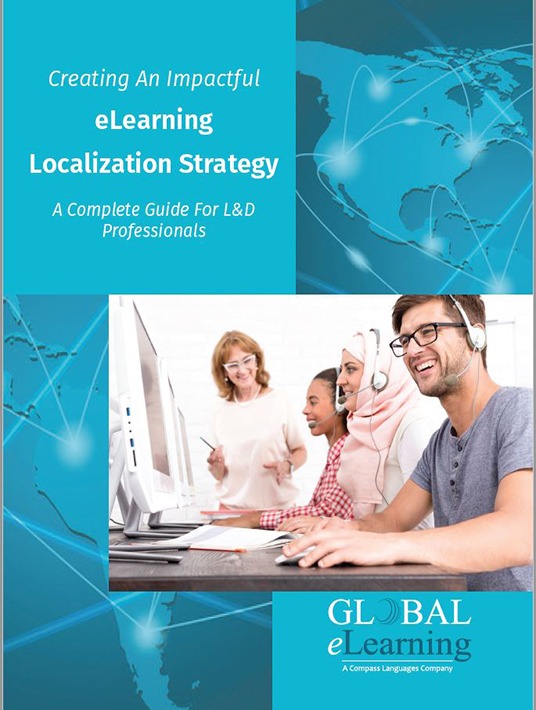Localized eLearning Content: How To Drive Cost And Schedule
Most corporations take great care in developing eLearning content for training purposes. Manufacturing processes, pharmaceutical sales strategies, and the administration of health care, to name just a few, require diligence to ensure that the overall message and intention of the training is accurate, compliant and effective. When it becomes necessary to translate and localize that content for a global audience, many companies struggle with the effectiveness, costs, and scheduling aspects of the localization process. In this article, we discuss the factors and complexities that drive localization costs and schedules, and how you can manage them effectively.

A successful eLearning localization strategy must begin with knowledge of the work required to produce a new language version of L&D content. For customers who are new to the field of localization, there are many factors that should be considered when localizing content. First, we want to ensure our readers understand that eLearning content should not merely be translated. As described in the previous article, in order for eLearning to be effective in the new language, each component of the eLearning content must be evaluated to determine its appropriateness in the new language. Audio, graphics, images, animation, etc. must all be reviewed, with an eye (and an ear) for how the message is interpreted and understood in the new language.
As a caution to those unfamiliar, there may be a fair amount of sticker-shock when you receive quotes for localization services. The surprise may be when stakeholders realize that, on average, a 30-minute Storyline or Captivate module, with moderate complexity in design, may cost several thousand dollars per language to localize. If the project involves 5 or 10 languages, then it can multiply to a large number rather quickly.
In addition, quotes from multiple Language Service Companies (LSCs) may vary significantly. Indeed, the proverbial apples-to-oranges comparisons of scope or SOW assumptions will be the cause. To some vendors, the work is only to translate text, prepare a new language script, and maybe organize for the voice-over studio recording. They may never consider the engineering side of the layout, synchronization, on-screen text manipulation, video editing, phrase synching, animation timing, and functionality testing.
Another surprise may be the time required to produce localized versions. On the same project described above, the quote’s schedule may come back in the range of 4-8 weeks. This can present real challenges when localization is an after-thought and the launch date is rapidly approaching.
Before explaining the many factors contributing to cost and schedule, it is important to note that there are companies (localization vendors) who simply translate and voice content and then there are companies who specialize in eLearning content localization. This can create a wide difference in understanding the scope, and most importantly, the outcome of the project. Per our guidelines in our previous article, choose a language company that is competent in the full scope of authentic localization. As an incentive, these select language companies have processes and resources that should generate efficiencies that significantly reduce the cost and turnaround time of the project.
The start of this review is the most obvious (common sense) drivers of cost/schedule; those drivers with straight-forward linear relationships:
- The length of modules: in # of slides, # of video minutes, or # of pages (words); if the cost of a Storyline module of 30 minutes/30 slides = $X, then a module of 60 minutes/60 slides = $2X, etc.
- The number of target languages, again, if 1 language = $X, three languages = $3X, seven languages = $7X
- Target Languages: English to Spanish is the most affordable language pair; localizing to primary Euro languages may cost an extra 15-25% while more exotic languages will cost an extra 40-45%. Human translation costs follow a fairly pure supply/demand in economic price performance. The greater supply of linguists will move prices down.
- How many modules in aggregate need to be localized?
- How many languages do we really need to localize into?
There are no economy-of-scale production tricks to overcome the linear nature of costs associated with the volume. Beyond these common core cost variables, there are more advanced variables that impact the cost of localization in less significant ways. They are:
Module Complexity
The quick indicator is the # of Layers. The number of layers per slide grows with graphical content, special effects, animation, interaction flow/detail, embedded videos, and other factors that increase the time of engineering.
Voice-Over
The amount of voiceover audio recordings to be incorporated into the presentation. This incorporates two variables: the number of slides with voice overlays and the number of recordings required per slide to accommodate special effects and interactions.
Voice Talent
The requirement for multiple voices and/or a specific voice, accent or dialect may increase cost and may sometimes extend the schedule.
The Authoring Tool
The engineering time to synch all components does vary among the authoring tools. Custom platforms can introduce additional time because of the learning curve effect in learning to maneuver through the platform.
Linguist Exclusion
When stakeholders impose restrictions on resources used to contribute to the localization process costs will absolutely rise accordingly. Some organizations want to use only U.S.-based linguists or exclude linguists that are residents of certain countries (OFAC restriction within U.S. Government). Costs increase because of the smaller pool of available linguists with the right subject matter expertise and experience.
Quality Assurance
If the organization sponsoring the creation of localized versions does not have a trustworthy internal reviewer in the target language (e.g., staff member in target country), they may try to add other QA measures which can drive a much higher cost, techniques such as back translations or contracting a second language company to check the work of original language company. Some rely on software tools for QA assessments that may yield confusing results (false positives).
Creative Source
When content developers are extremely creative with the original content, they may limit redundant terminology or phrases. Yet, it is redundancy (repeat) that acts to reduce the cost of translation and provides a more consistent translation.
Technical Source
If the topic is exceptionally technical, then the linguist pool of people who are competent to translate shrinks dramatically. Less supply = higher costs.
Accessibility Requirements
508 compliance and WCAG 2.1 requirements can increase costs by 20-40% depending upon the level of compliance required. These requirements are imposed when the target audience includes those with reading/hearing disabilities.
Content Involving Transcreation
Content containing poetic verses, time-constrained or space-constrained translations, idioms, or contains considerable text that drives emotional responses will require a transcreation process instead of the normal translation process.
Finally, stakeholders themselves can be the cause of cost overruns and missed deadlines. As a localization partner to many companies and federal government entities, we have to warn our sponsors of disruptive practices, almost all of which occur during the production process or in post-production reviews. Only the first bullet point below significantly impacts cost, but all of them impact the schedule.
- Source content changes mid-stream. The too-oft situation where the project begins with provided source content, and then mid-stream of project execution, a stakeholder/sponsor sends modified source content and says, “last-minute change, use this instead”.
- A client requesting directorial input into voice recordings. Clients have the right to provide directorial input into the recording session but the extra time can add up when studios and voice talents charge by the hour.
- Client spending extraordinary time approving translated script. Often LSCs will request stakeholder approval of a translated script before spending the money on studio recordings. When the stakeholder takes a very long time to approve or give feedback, studio schedules for the voice talent can get messy.
- Client allowing multiple internal reviewers to alternate in a review of the vendor’s translation. Language companies have horror stories of receiving feedback on a localized version, correcting the errors and re-submitting, only to receive a fresh set of new corrections. When stakeholders introduce a second or even third internal reviewer, the result is that reviewers will contradict each other in style preferences. This causes the language company to have a moving target on style alignment and endless corrections.
Hopefully, this insight into the localization process will deepen your understanding such that a more complete eLearning localization strategy can be envisioned. In a future article, we will establish the best practices to implement in order to produce a cost and schedule effective localization process and strategy.
The Learning & Development professional is facing a growing demand for global adaptations of corporate training content. Download our eBook Creating An Impactful eLearning Localization Strategy: A Complete Guide For L&D Professionals to discover how a great eLearning localization strategy can help you turn your employees into rising stars and unlock their true potential. It also features tips to go global by launching an engaging program for your multicultural workforce.









